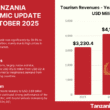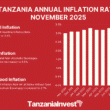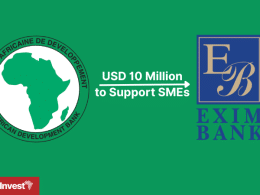Emmanuel Tutuba, the newly appointed Governor of the Bank of Tanzania (BOT), sat down with Eric Tirabassi, Chief Editor of TanzaniaInvest, for an exclusive interview.
Tutuba’s career in finance has seen him serve as the Permanent Secretary of the Ministry of Finance and Planning since 2021, before being appointed Governor in January 2023.
In the interview, Tutuba discussed the economic challenges facing Tanzania and the global economy such as high inflation, currency fluctuations and its impact on trade, and shares his insights on the country’s current GDP growth and highlighted the promising outlook for the Tanzanian economy in the coming years.
He also discussed BOT’s monetary policies and the role of Tanzanian banks in supporting economic growth, and highlighted the positive impact of digitalization and new products such as Islamic banking for greater financial inclusion.
Tutuba also weighed in on the hot-button issue of cryptocurrencies and shared his thoughts on the potential for a Central Bank Digital Currency (CBDC) for Tanzania.
Overall, the interview provides valuable insights into Tanzania’s macroeconomic fundamentals and economic outlook and how the banking system is evolving to accompany faster GDP growth.
Economic Growth and Inflation
TanzaniaInvest (TI): The primary objective of BOT is to formulate and implement monetary policies directed at maintaining domestic price stability and sustainable economic growth. The price stability has been disrupted first by the Covid-19 pandemic, but the Bank has reacted promptly with ad-hoc measures and then by the ongoing Russia-Ukraine conflict and its impact on the global value chain, with the annual inflation rate at a five-year high in January 2023 at 4.9% to eventually go down to 4.7% in March 2023. Meanwhile, the country’s GDP growth rate has been slowing down in recent years, from a peak of +7.9% in 2011 to +4.6% in 2022 according to the World Bank’s latest estimates. What is your monetary policy strategy to tame inflation and accelerate economic growth? What are BOT’s expectations for 2022, 2023, and beyond?
Emmanuel Tutuba (ET): Tanzania like many other countries was not spared from the global shocks, which continue to have detrimental effects on economic growth and commodity prices through supply chain disruptions. These effects, compounded by climate-related constraints, have caused low economic growth and rising inflation. In addressing the shocks, BOT pursued a cautious monetary policy stance aimed at striking a balance between supporting the ongoing recovery of economic activities and controlling inflationary pressures. This policy stance, which is less accommodative, helped to contain inflation within the target of 5.4% for 2022/23, while providing adequate liquidity for the growth of credit to the private sector. The conducive policies (fiscal and monetary) helped the economy to register a modest recovery from the effects of Covid-19, with a growth of 4.9% in 2021 from 4.8% in 2020. Based on high-frequency indicators of economic activities, we estimate GDP growth to further recover to around 5% in 2022, higher than the earlier growth projection of 4.7%.
“Based on high-frequency indicators of economic activities, we estimate GDP growth to further recover to around 5% in 2022, higher than the earlier growth projection of 4.7%.”
We are not out of the woods yet, as we expect the economy to continue facing headwinds from spill-overs of the war in Ukraine in the near term. Thus, monetary policy will remain less accommodative in 2023 and beyond to tame the second-round effects of global shocks on inflation expectations, while safeguarding the growth of economic activities.
Inflation is projected to increase but maintained within the country’s targets of not more than 5.4% for 2022/23 and around 4.5% in 2023/24, consistent with the projected easing of inflation in most advanced economies. In addition, adequate rainfalls in most food-producing areas are likely to lessen the pressure on domestic food prices.
“Inflation is projected to increase but maintained within the country’s targets of not more than 5.4% for 2022/23 and around 4.5% in 2023/24.”
Meanwhile, signs of recovery in the global economy have already started to unfold following the easing of the ongoing tension in Eastern Europe, coupled with China’s U-turn on its zero COVID policy. These promising circumstances are expected to improve economic activities and reduce inflation in the country, complemented by sustained prudence in macroeconomic policies, governments’ interventions to improve the business environment, infrastructure development, and recovery of private sector credit. GDP growth for Mainland Tanzania and Zanzibar is expected to be around 5.3% and 6.1% in 2023, respectively.
“GDP growth for Mainland Tanzania and Zanzibar is expected to be around 5.3% and 6.1% in 2023, respectively.”
Credit to Private Sector
TI: President Samia Suluhu Hassan made it clear that unlocking credit to the private sector-particularly to SMEs-is key to economic recovery and strong growth. In this regard, BOT introduced a set of relaxing policy measures to increase credit to the private sector and lower interest rates. If credit to the private sector is experiencing a fast growth of about 20% in 2022, the interest rates applied by banks still average 16%, and those applied by microfinance institutions are even higher. However, BOT also asked microfinance institutions to cap their rates (at 3.5% per month), while the Minister of Finance reminded them that market forces should determine the rates. What does it take to scale up credit to the private sector in a sustainable way? What are the ambitions and strategies in terms of interest rates in Tanzania?
ET: BOT has been taking policy measures from time to time, and will keep on taking policy measures to boost the growth of credit to the private sector, at an affordable cost of borrowing. The most recent happened on 27th July 2021, whereby BOT made a public statement that highlighted policy measures to promote credit to the private sector and lower interest rates, thereby hastening the recovery of the economy following the impact of the COVID-19 pandemic.
“BOT has been taking policy measures from time to time, and will keep on taking policy measures to boost the growth of credit to the private sector, at an affordable cost of borrowing.”
These measures included the following:
a) Reduction of Statutory Minimum Reserve Requirement (SMR).
The banks that extended credit to agriculture at an interest rate not exceeding 10% per annum were eligible for a reduction in statutory minimum reserve requirement equivalent to the amount of loan extended to agriculture activity;
b) Relaxation of agent banking eligibility criteria.
BOT removed the regulatory requirement of business experience of at least 18 months for applicants of agent banking business. Instead, applicants for agent banking business were required to have National ID Card or National ID Number;
c) Limitation of the interest rate paid on mobile money trust accounts.
The banks or financial institutions that maintained mobile money trust accounts were required to pay interest rates on deposit balances held in such accounts not exceeding the rate offered on savings deposit accounts by the respective bank or financial institution. This is intended to lower the cost of funds to banks, thus helping to reduce lending rates to customers;
d) Introduction of special loans amounting to TZS 1.0 trillion to banks and financial institutions for on-lending to the private sector.
BOT introduced a special loan facility to banks and financial institutions for on-lending to the private sector. To access this facility, a bank or financial institution had to meet some criteria which among others included:
-Charging interest rate not exceeding 10% per annum on loans extended to the private sector;
-Complying with the minimum capital requirement as prescribed in the Banking and Financial Institutions (Capital Adequacy) Regulations;
-Having recorded profit in at least four preceding consecutive quarters;
-Having recorded an increase in deposits over the last twelve months; and
– Having non-performing loans (NPLs) ratio not exceeding the industry average and NPLs of financed loans are not more than 5% to qualify for subsequent facilities.
e) Reduction of risk weight on loans.
BOT reduced risk weights on salaried loans from 100% to 50% for computing the regulatory capital of banks. For the computation of risk weight, salaried loans were to be reported together with residential mortgage loans as provided under BOT Form 16-1 Schedule 15(i). This measure aimed at reducing risk-weighted assets, increasing capital ratios and providing an opportunity for banks to extend more credit to the private sector.
Concerning the capping interest rates on Microfinance Institutions’ loans, Section 12 of the Microfinance Act, 2018 empowers BOT to oversee and monitor Microfinance Service Providers (MSPs) operating or undertaking microfinance business in Tanzania. Further, Section 60 of the Act empowers the Bank to issue regulations prescribing procedures for the application of license, permissible activities, consumer protection, payments to be made, and matters of provision of financial education and various fees payable.
As stipulated in the Microfinance (Non-Deposit Taking Microfinance Service Providers) Regulations 2019, during the application process, applicants are required to submit various documents including the lending policy. The policy is required to indicate types of products, eligibility criteria, loan duration, interest rates, fees and charges, collaterals required for various loans and recovery and collection process. Until 17th February 2023, BOT had received 1,639 applications and licensed 1,154 tier 2 MSPs, none of which had substantiated lending rates higher than 3.5% per month or 42% per annum. Given that, it is not true that BOT directed Microfinance Institutions to cap their interest rates at 3.5% per month/42% per annum. Notably, it has been difficult for Microfinance Institutions (MFIs) to demonstrate lending rates exceeding 3.5% per month in their lending cost structure which includes the cost of funds, administration costs, and profit margins. It is from that background that other licensed MFIs are charging less than 3.5% per month.
Non-Perfuming Loans (NPLs)
TI: Banks operating in Tanzania are all suffering from high ratios of NPLs, although to a lesser extent than before, with NPLs to gross loans down to 7.8% in June 2022 from 9.3% in the corresponding period in 2021. However, the ratio remains above the desired level of 5%. BOT established that some banks are directly responsible for the NPLs, issuing loans without properly following procedures. However, banks blame ineffective judiciary and uncertain legal consequences for defaulters. What measures have been taken to reduce NPLs?
ET: BOT has been taking various measures to reduce Non-Perfuming Loans (NPLs). Some of the measures taken include the following:
a) Enforcing a code of conducts for banks’ staff in collaboration with Tanzania Bankers Association (TBA);
b) Requiring banks and financial institutions to terminate dishonest staff and submit their details to the Bank for inclusion in the black-list;
c) Enforcing mandatory use of credit reports from credit reference bureaus to enhance the credit underwriting process;
d) Ensuring a fair and level playing field through enforcement of BOT (Financial Consumer Protection) Regulations, 2019;
e) Enforcing the Banking and Financial Institutions (Corporate Governance) Regulations, 2021 to provide guidance to directors for the proper discharge of their fiduciary responsibilities; and
f) Restricting payment of dividends and bonuses for banks and financial institutions with NPLs ratio above the acceptable level of 5.00%.
Consequently, during the period ending 31st December 2022, the ratio of Non-Performing to gross loans (NPLs Ratio) had decreased to 5.77% compared to 8.47% recorded in the corresponding period of 2021.
“During the period ending 31st December 2022, the ratio of Non-Performing to gross loans (NPLs Ratio) had decreased to 5.77% compared to 8.47% recorded in the corresponding period of 2021.”
BOT, in collaboration with the Governments and other stakeholders, will continue to undertake various measures to reduce NPLs and encourage credit growth to the economy. This is to keep pace with the development aspiration of Dr Samia Hassan Suluhu, the President of the United Republic of Tanzania. Banks and other financial institutions are called upon to fully cooperate and support the initiatives taken by BOT to enhance the growth of credit to the economy at affordable lending rates, as well as reduce NPLs to acceptable levels.
“Banks and other financial institutions are called upon to fully cooperate and support the initiatives taken by BOT to enhance the growth of credit to the economy at affordable lending rates.”
Banking Sector Consolidation
TI: According to BOT’s latest Monetary Policy Statement of February 2023, which reviews the outcome of the implementation of the monetary policy during the first half of 2022/23, Tanzania’s financial sector is expected to remain stable and resilient in supporting its growth agenda. Indeed, Tanzania’s largest banks experienced great improvements in profitability in 2021 and 2022 after putting in place contingency plans to mitigate the impact of the COVID-19 pandemic. However, the banking landscape is very heterogeneous, with 47 licensed banks, and the five largest banks alone account for accounting for 60% of the total assets as of the end of 2021, and some smaller banks find it hard to meet regulatory requirements regarding liquidity and capital adequacy. Is there a need for so many financial institutions? Do you expect consolidation in the banking sector in the near future?
ET: The role of the BOT, apart from being a regulator, is to ensure a conducive and enabling environment for financial sector players to implement various measures to enhance access and usage of formal financial services. Since capital adequacy and wider coverage are among the key success factors of a financial institution, BOT encourages financial institutions to merge in a bid to enhance their financial muscles and benefit from the synergies of mergers. Mergers and/or acquisitions may enable financial institutions to have a wider outreach and even provide financing to the country’s strategic projects. However, BOT does not interfere with mergers or acquisition decisions in the financial sector, and that is purely the decision of the financial institutions.
“BOT encourages financial institutions to merge in a bid to enhance their financial muscles and benefit from the synergies of mergers.”
Exchange Rate & Current Account
TI: Despite the shocks in the global economy, the Tanzanian shilling maintained stability against the dollar and other major currencies as depreciation was moderate and sustainable, below 1% throughout 2022. However, over the long term, the shilling has been constantly depreciating against the dollar since the 1980s. What is the reason for that and what is the overall impact on the country’s trade balance, with a widening current account deficit, largely on account of the high import bill, particularly petroleum products?
ET: Despite the shocks in the global economy, the Tanzanian shilling remained stable against the currencies of major trading partners. The shilling traded at an average of TZS 2,314.5 per USD in 2022, compared with TZS 2,309.2 per USD in 2021, representing a depreciation of less than 1%. The stability of the shilling was mainly on account of low inflation relative to those of the major trading partners, and prudent monetary and fiscal policies, supported by market confidence due to the adequacy of foreign exchange reserves.
“Despite the shocks in the global economy, the Tanzanian shilling remained stable against the currencies of major trading partners [with] a depreciation of less than 1%.”
With respect to the relationship between depreciation and current account deficit, essentially, depreciation leads to cheaper exports and more expensive imports, which in turn could lead to a reduction in the deficit of the current account by increasing the amount of goods exported and simultaneously decreasing the quantity of imported goods. However, this is contingent on the responsiveness of exports/imports to the movement in prices.
Tanzania mainly imports machinery and transport equipment, oil products and industrial supplies critical for production and investment—these goods are normally not highly responsive to price changes. Exports, which are mostly minerals, manufactured goods and cash crops have been increasing, however, not enough to absorb the demand for foreign currency emanating from the rising import bill, thus stimulating further depreciation of the local currency.
“Exports have been increasing, however, not enough to absorb the demand for foreign currency emanating from the rising import bill, thus stimulating further depreciation of the local currency.”
Over time the current account deficit has remained sustainable, although recently we have been experiencing a widening of the account due to a higher import bill associated with the spillover effects of the war in Ukraine. Given the increased importation, which is explained by a drive for public investment and industrialization in the country, it is our hope that it would reap long-term benefits in the form of increased productive capacity, which will stimulate production and increase exports.
Digitalization & Financial Inclusion
TI: The digitalization of financial services is contributing significantly to the realization of the country’s objectives of greater financial inclusion through the development of digital savings and credit services, with the Fintech start-up landscape in Tanzania evolving rapidly. However, findings of the United Nations Capital Development Fund indicate that the majority of Fintech start-ups in Tanzania struggle to survive because they are not able to gain traction in the market or lack funding to sustain their operations. From your perspective, what role are banks best suited to play in the advancement of the Fintech ecosystem in Tanzania? Should they be competing or cooperating with Fintechs?
TI: In my opinion, banks play a critical role in advancing financial services and products. They have been at the centre of enhancing intermediation in the country, agile and adaptive to technological advancements which we currently witness. In the same vein, I expect them to continue to embrace the advancement of Fintech in Tanzania. This includes continued collaboration with innovators to advance banking services and enhance financial inclusion and deepening in the country, and investing in Fintech solutions that unlock barriers to access and usage of formal financial services.
In a bid to encourage and foster innovation in the financial sector, BOT is working towards establishing a Fintech regulatory sandbox that will enable Fintech companies to test innovative and transformative solutions in a controlled environment for financial service delivery in the country.
“BOT is working towards establishing a Fintech regulatory sandbox that will enable Fintech companies to test innovative and transformative solutions in a controlled environment for financial service delivery in the country.”
Cryptocurrencies
TI: There is a growing trend among Tanzanians in engaging in activities related to cryptocurrencies. BOT asked to beware of these virtual currencies, as they are not legally authorized in Tanzania. As for CBDC, after months of research, BOT has recently decided to adopt a phased, cautious, and risk-based approach to its adoption. Why the need to regulate cryptocurrencies that are designed to be free from government manipulation and control, and are backed instead by decentralized blockchain technology without the need for a trusted third party?
ET: The absence of regulation, especially in financial services, poses several risks, not only to consumers but also to the financial system and the economy at large. This is a concern of any central bank and that is why we had to issue the warning notice you have referred to. As you are aware, cryptocurrencies have caused huge losses to consumers in several markets across the globe, despite the underlying technology (decentralized blockchain that has the potential for transforming several industries). Noteworthy, in most of these jurisdictions the cryptocurrencies are not regulated, leaving consumers at the fate of issuers of the cryptos.
It is, therefore, prudent that the cryptocurrency industry should be regulated to protect consumers, mitigate against potential risks of money laundering, terrorist financing and proliferation financing, as well as mitigate against other financial stability risks and price stability risks. While central banks endeavour to regulate the cryptocurrency market, there are several challenges along the way, such as the cross-border nature of the operations of cryptos issuers and exchanges (online offered from foreign jurisdictions). Despite these challenges, jurisdictions across the globe are devising monitoring and regulatory approaches to regulating the sector. We are also inclined in the same vain to mitigate the risks aforementioned.
TI: What are the pros and cons of a Tanzanian CBDC, and do you envision one?
ET: In the Public Notice that we issued, we pointed out that we are at the exploratory stage and have decided to take a cautious approach. Besides, it is too early to point out the pros and cons of a Tanzanian CBDC, since we currently do not have a strong use case that warrants the issuance of a CBDC in the short term.
The decision to issue CBDC for Tanzania should be based on a clear use case or problem that the CBDC will address. Our current strategy is to advance and promote efficient electronic payments for inclusive access to a wider population base. We are also working with the Government to ensure that the underlying supportive infrastructure is available national-wide, in the absence of which, electronic payments or CBDC would not be a viable venture that benefits the citizenry.
“The decision to issue a Central Bank Digital Currency (CBDC) for Tanzania should be based on a clear use case or problem that the CBDC will address. Our current strategy is to advance and promote efficient electronic payments for inclusive access to a wider population base.”
That said, from our analysis, we have noted several risks that CBDC may pose to an economy if its adoption is not well designed and implemented. The risks include cybersecurity risks, fraud, privacy and data protection issues, negative disruptions on existing schemes and systems, digital divide, and disintermediation (if not well designed). On the advantages, they depend again on the design, and from research (we are yet to test them in Tanzania), may include, facilitation of effective flow and monitoring of money, and reduction of transaction costs (but this is likely to happen only if all other underlying factors are available such as universal access to digital infrastructure, access to smartphones, etc.)
The current stance of BOT after undertaking several research studies is that it is prudent to take a risk-based cautionary approach and continue exploring the trends and enhance broader understanding. Meanwhile, we are working with the Government to ensure that the underlying critical infrastructure and other enablers are widely available. This will enable BOT and the country at large to avoid the risk of rushing into the predicaments that befall first movers of adopting new technology, which include absorbing all potential technological risks, operational risks and losses.
Islamic Banking
TI: Tanzania’s population of 60 million is approximately 34% Muslim. Sharia-compliant banking in Tanzania is in its infancy but growing. There is only one fully-fledged Islamic bank-Amana Bank, and a few other commercial banks have started offering Islamic financial services. In 2021, the first Sukuk bond was issued in Tanzania, which was oversubscribed by 36%. However, there is currently no specific legal framework to cater for Islamic banking in Tanzania as well as the resolution of legal disputes arising from Islamic banking. What are the Bank’s expectations on this segment of the sector, and which initiatives can we expect?
ET: In 2013 the Government of the United Republic of Tanzania requested assistance from the World Bank to study and advise on the establishment of a legal, regulatory and supervisory framework for Islamic Banking and Finance in Tanzania. The request for technical assistance was driven by the fact that the banking sector had one full-fledged Islamic bank namely Amana Bank Ltd and three conventional banks offering Islamic products namely KCB Bank, The National Bank of Commerce, and the Peoples Bank of Zanzibar. However, CRDB is another bank that has recently started offering Shari’ah-compliant banking products through its Islamic banking window.
The World Bank conducted the study and submitted a report to the Government of the United Republic of Tanzania, containing a wide range of recommendations that would make Islamic Banking and Finance feasible in Tanzania. These measures covered various policy and legislative areas including banking, capital markets, insurance, taxation and issues related to corporate governance.
After the completion of the mission, in 2017 BOT invited a number of stakeholders to a roundtable discussion about the subject matter. The stakeholders included the Ministry of Finance and Planning; Ministry of Justice and Constitutional Affairs; Tanzania Revenue Authority; Tanzania Insurance Regulatory Authority; Capital Markets and Securities Authority; Business Registration and Licensing Authority; and Centre for Islamic Finance, Consultancy and Advice (CIFCA). Following this meeting, an action plan was prepared whereby various tasks were assigned to relevant stakeholders. BOT, as a regulator and supervisor of banks and financial institutions that constitute approximately 70% of the total assets of the financial sector, was selected to be a coordinator of the exercise of developing and implementing the Islamic Banking and Finance Framework in Tanzania.
BOT embarked on the implementation of the Action Plan as advised by the World Bank by among others, reviewing and monitoring the application of policies used by banks in conducting Islamic Banking and Finance through available supervisory tools. In addition, BOT organized various trainings on Islamic Banking and Finance that were facilitated by CIFCA.
In early 2022, BOT formed the Islamic Banking and Finance (IBF) technical team, which was tasked to spearhead the exercise of developing and implementing the framework for Islamic Banking and Finance. In November 2022, the technical team conducted desk research to analyze Islamic Banking and Finance practices in selected jurisdictions that have a similar banking operating environment to ours and have developed and implemented Islamic Banking and Finance framework.
In January 2023, BOT requested proposals and recommendations from different Islamic Banking and Finance stakeholders on legal and regulatory changes that will make Islamic Banking and Finance more feasible in Tanzania. Legislations that may need to be amended include the following:
(a) The Bank of Tanzania Act, [Cap 197 of 2006];
(b) The Banking and Financial Institutions Act, [Cap 342 of 2006];
(c) The Microfinance Act, [Cap 423 of 2018]; and
(d) The Government Loans, Guarantees and Grants Act, 1974.
By June 2024, we expect that the Prudential Regulations, Guidelines and Circulars on Islamic Banking and Finance will be issued to all banks and financial institutions. These will, among others, provide guidance on the conduct of Islamic banking in Tanzania as well as the handling of disputes arising from Islamic banking.
“By June 2024, we expect that the Prudential Regulations, Guidelines and Circulars on Islamic Banking and Finance will be issued to all banks and financial institutions.”
Development Financial Institutions
TI: Infrastructure development projects are a structural component of Tanzania’s socio-economic progress. This requires long-term financing and the support of development finance institutions. The two Tanzanian development banks, TIB and TADB, faced structural factors undermining their lending capacity but the Banking and Financial Institutions (Development Finance) Regulations of 2021 address them. How satisfied are you with the current dynamism of these market players in assisting the socio-economic development of Tanzania in the next few years?
ET: The main objective of TIB Development Bank is to finance long-term projects for economic development while TADB’s objective is to provide long-term financing for the agricultural sector and loans to activities that contribute in value addition to the agricultural products.
TIB Development Bank has been facing challenges of inadequate capital and liquidity squeeze that affect the bank’s capacity to finance long-term development projects. The Banking and Financial Institutions (Development Finance) Regulations, 2021 provide a moratorium period for the banks to comply with the minimum capital requirements, which require Government efforts as the shareholder to ensure that the challenges are addressed. Meanwhile, TADB has adequate capital and liquidity to meet its objectives of financing long-term agricultural projects.
Despite the inadequate contribution of Development Financial Institutions (DFIs), socio-economic development in Tanzania is expected to continue progressing well in the medium to long term, supported by other players in the financial sector and Governments’ initiatives on development projects and provision of social services. However, there is a need for intervention by the Government and other stakeholders, for the country to have vibrant DFIs, which will bring about greater outcomes to the economy and provision of social services.
“Despite the inadequate contribution of Development Financial Institutions (DFIs), socio-economic development in Tanzania is expected to continue progressing well in the medium to long term, supported by other players in the financial sector.”










